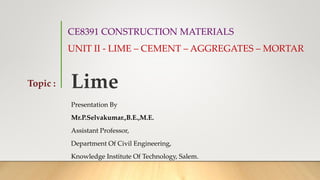
Lime - Classification, Properties, Uses
- 1. CE8391 CONSTRUCTION MATERIALS UNIT II - LIME – CEMENT – AGGREGATES – MORTAR Presentation By Mr.P.Selvakumar.,B.E.,M.E. Assistant Professor, Department Of Civil Engineering, Knowledge Institute Of Technology, Salem. Topic : Lime
- 2. Introduction to Lime • Lime is produced by heating limestone which is more or less pure calcium carbonate. • During heating, carbon-dioxide driven off and non- volatile impurities such as oxides of silicon, magnesium, aluminium, iron and manganese are left behind in the lime.
- 3. Introduction to Lime • Lime or quicklime as it is sometimes called is an essentially calcium oxide, CaO. • Pure calcium oxide is a white solid which melts at 2570 °C. • Lime has been used as a material of construction from ancient times. Egyptians used lime for plastering, while Romans used this material extensively for making mortar, plaster and concrete. • In India, the historical structures such as palaces, massive forts, dams and bridges, etc., were built with lime as cementing material.
- 4. Uses of Lime • Raw material for cement • Lime mortar for building stone and brick walls • Plastering of walls and ceilings • Used for white washing and base coat for distempers. • Used to manufacturing of wall care putty and paints. • Used for making Plaster of Paris. • Used for production of artificial stones.
- 5. Technical terms Calcination Calcination is the process of heating limestone to redness in contact with air. Due to calcination, the moisture and carbon dioxide are removed from the limestone and the remaining product is known as Lime; its chemical composition is oxide of calcium (Cao). The chemical reaction is as follows: CaCO3 = Cao + CO2 Lime stone Lime Carbon di oxide
- 6. Technical terms Slaking It is the process of chemical combination of quick lime with required quantity of water for killing the heat and getting into powder form for use. CaO + H2O = Ca(OH)2 Quick Lime Water Hydrate of Lime
- 7. Technical terms Hydraulicity • It is the property due to which lime (or cement) will set in damp places or under water or in thick masonry walls there is no free access of air. • By hydraulicity the lime can evolve heat and initiate the setting. • Pure limestone and sand do not possess hydraulic property.
- 8. Technical terms Setting • It is the hardening of lime which has been mixed to a paste with water. • During setting, the heat will evolve and drying the paste. • After drying, no setting action takes place.
- 9. Classification of lime 1. Fat Lime 2. Hydraulic Lime 3. Poor Lime
- 10. Fat Lime • It is also known as rich, fat, common, high calcium, air or pure lime. • It is so called (fat lime) as it slakes vigorously and its volume is increased to about 2 to 2.5 times the volume of quick lime. • It is prepared by calcining comparatively pure carbonate of lime which contains about 95% of calcium oxide.
- 11. Uses of Fat Lime • It is used in whitewashing and plastering walls. • Lime mortar, made of lime and sand, is used for thin joints of brickwork and stonework. • Lime mortar, made of lime and surkhi (powder obtained by grinding of burnt bricks) may be used for thick masonry walls, foundations, etc.
- 12. Hydraulic Lime • It is also known as water lime. The hydraulic lime, depending upon the percentage clay is divided into the following three types: (i) Feebly hydraulic lime (ii) Moderately hydraulic lime (ii) Eminently hydraulic lime.
- 13. Properties of Hydraulic Lime • The increase in percentage of clay makes the slaking difficult and increases the hydraulic property. • It can set under water and in thick walls where there is no free circulation of air. • It forms a thin paste with water. • It is not perfectly white in colour, as such it appears less sanitary than the fat lime. • The hydraulic lime containing about 30% of clay resembles natural cement.
- 14. Properties and uses of Hydraulic Lime S. No Aspects Feebly hydraulic lime Moderately Hydraulic lime Eminently hydraulic lime 1 Percentage of clay 5 to 10 11 to 20 21 to 30 2 Slaking time Few minutes 1 to 2 hours Long time 3 Setting time 3 weeks 1 week 1 day 4 Hydraulicity Feeble Moderate Eminent 5 Uses Ordinary masonry work Superior masonry work Damp places
- 15. Poor Lime - Properties • It is also known as lean or meagre lime. • It contains more than 30% of clay. • Its colour is muddy white. • It slakes very slowly. • It forms a thin paste with water. • It sets/hardens very slowly. • It has poor binding properties.
- 16. Poor Lime - Uses • As the mortar made from this type of lime is of poor quality, therefore, mortar is employed for inferior type of work.
- 17. Classification based on ISI Class A: Eminently hydraulic lime - used for structural purposes. Class B: Semi-hydraulic lime used for masonry mortars. Class C: Fat lime used for finishing coat of plastering, whitewashing, etc., and with addition of pozzolanic material for masonry mortar. Class D: Magnesium lime - used for finishing coat in plastering, whitewashing, ect. Class F: Kankar lime - used for masonry mortars.
